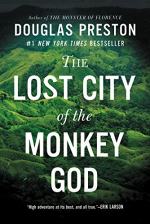|
This section contains 389 words (approx. 1 page at 400 words per page) |

|
The Lost City of the Monkey God Summary & Study Guide Description
The Lost City of the Monkey God Summary & Study Guide includes comprehensive information and analysis to help you understand the book. This study guide contains the following sections:
This detailed literature summary also contains Topics for Discussion on The Lost City of the Monkey God by Preston, Douglas .
This summary refers to Douglas Preston's Lost City of the Monkey God, published by Hachette Book Group in 2017.
Preston's book is a first-hand account of a dangerous expedition into the heart of Mosquitia, an area of Honduras, to find the lost city, alternatively called the White City and the Lost City of the Monkey God, that has long been rumored to exist there. Preston begins his narrative in when the expedition is in Catacamas, Honduras, a dangerous city controlled by drug dealers from which they will leave to enter the rainforest. There, they hear about the dangers of the trip ahead, including venomous snakes, scorpions and spiders, and deadly diseases. The author then recounts his first encounter with Steve Elkins, the cinematographer and adventurer whose dream it is to find the lost city.
The author then delves into the long history of the myth making that has surrounded the lost city for hundreds of years, dating back to Cortes. He includes the strange stories of hucksters, such as Thedore Morde, who ventured into Honduras in 1940 and who claimed to have found a remarkable city ruled over by the statue of a monkey god. Despite Morde's popularity with the press at the time, his stories, as Preston reveals, were frauds--something that Preston realizes when he gets his hands on Morde's journals.
Preston then returns to Steve Elkins's long and difficult twenty-year quest to produce a lidar, or radar map, of the area called T! in Honduras where he thinks the lost city might be located and the remarkable finds that the lidar map reveals. He covers the expedition into the Edenic-like T1 in 2015, in which the group makes remarkable finds connected to an unknown civilization that was distinct from the Maya. He then, like many members of the expedition, is struck by leishmaniasis, caused by sand flies that inject parasites into humans. He recounts his treatment for the disease at the National Institutes of Health and then connects his experience with the disease to the experiences of New World people who died in droves when they faced Old World diseases that Europeans brought to the New World and against which they had no resistance. He concludes his tale with a warning about the impermanence of even great civilizations and the dangers that diseases pose for the modern world.
Read more from the Study Guide
|
This section contains 389 words (approx. 1 page at 400 words per page) |

|



